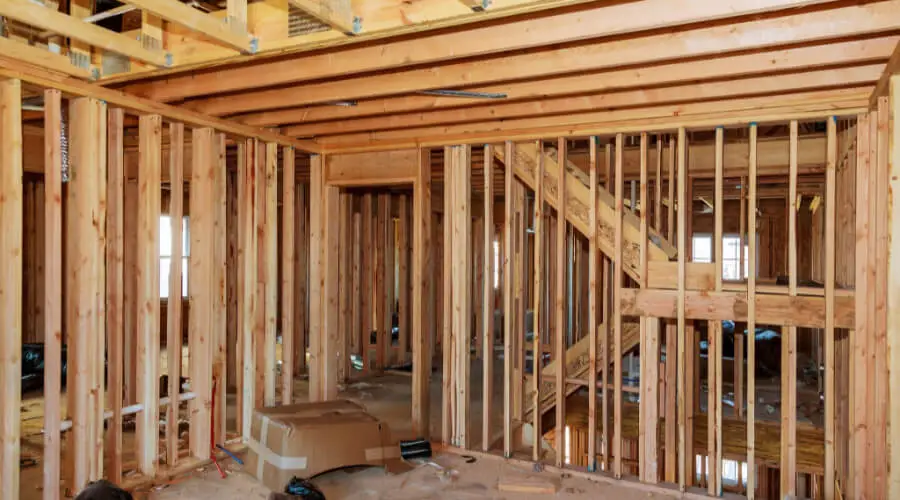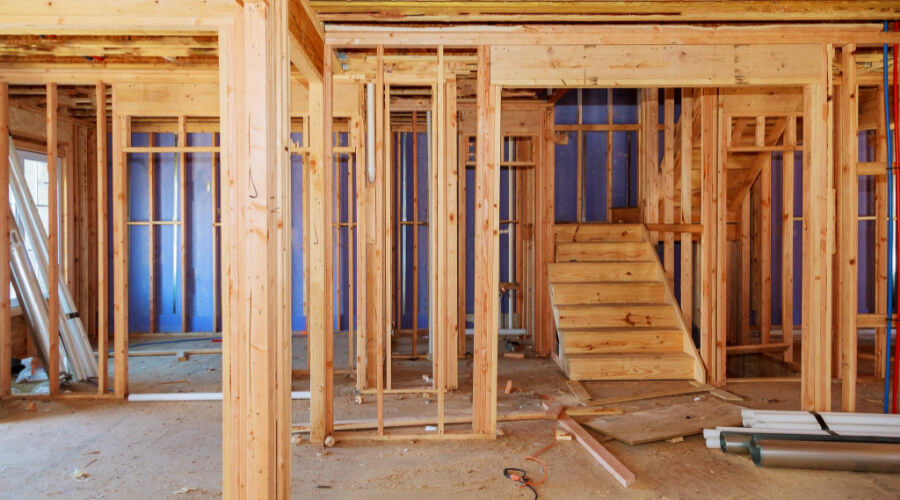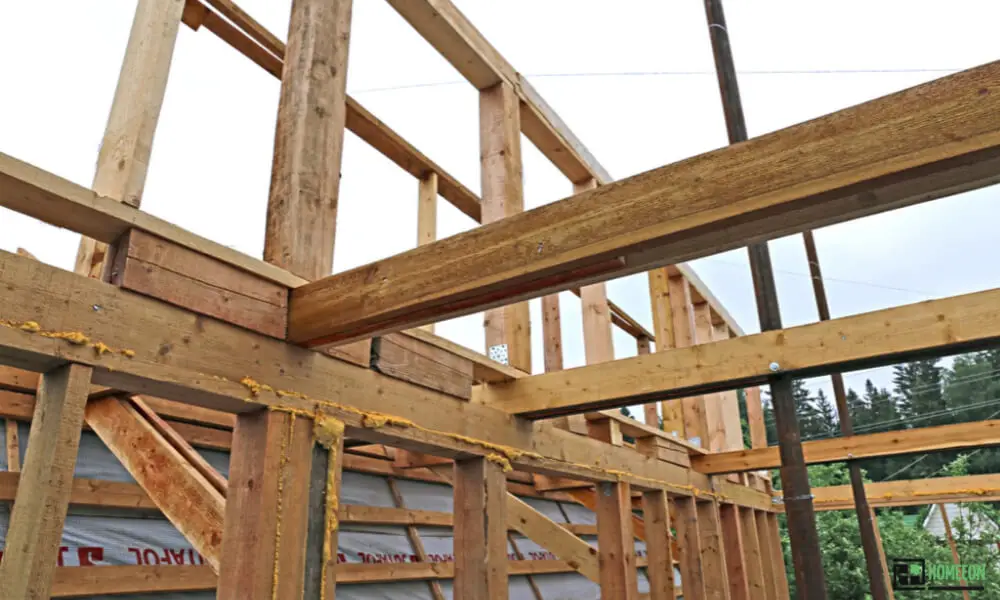Last Updated on July 30, 2023 By Emma W. Thomas
To sister joists, follow these steps:
- Assess the damaged joist’s length and dimensions.
- Obtain a new joist of the same size and material.
- Place the new joist alongside the damaged one.
- Nail or screw them together with construction adhesive.
- Use joist hangers for added support if necessary.
- Ensure a snug fit and proper alignment before securing.
- Reinforce the sistered joists as needed for structural integrity.
What is Joist Sistering?
Joist sistering is a technique used in construction and carpentry to reinforce or repair existing joists in a floor or ceiling structure. It involves attaching a new joist alongside an existing, damaged, or undersized joist. By doing so, the load-bearing capacity and overall strength of the floor or ceiling system are improved, ensuring better structural integrity and support. Sistering is commonly employed when the original joists are weakened due to age, decay, or damage.
What Length Should a Sister Joist be?
| Severity of Damage/Repair | Recommended Sister Joist Length |
|---|---|
| Severe damage, and significant reinforcement required | At least 3 feet on each side of the damaged area |
| Moderate damage or undersized joist | At least 3 to 6 feet on each side of the damaged area |
| The severity of Damage/Repair | Longer than 6 feet on each side of the damaged area |
| Structural modifications or heavy loads | Length determined by a structural engineer or building code requirements |
Reasons For The Damaged Floor Joists

Floor joists are mostly made of engineered or natural wood. And, depending on the location, building codes of the area, and projected load capacity, the joist can be doubled or even tripled. But, despite all the effort, the floor joists sometimes fail.
Some of the reasons for damaged floor joists include:
Crawl Space Moisture
Outside humidity, groundwater flooding, and exposed damp ground can make crawl spaces moist. As a result, the joist woods dampen and eventually weaken due to wood rots and fungus. Your structure, therefore, will lose integral strength, calling for immediate repairs.
Water Damage
Plumbing leaks can cause water damage to your joists as it causes the wood to rot. For the already sagging joists, water will naturally accelerate the damage to the floor joists.
Termite Infestation
Termites are small insects that can cause your building to collapse if the issue is not addressed. They eat on the joist woods, eventually leading to sagging floors. For termite infestation, sister the joists and work on getting rid of the insects.
How To Do Joist Sistering

Joist sistering is best left to the professionals. However, if you want to try it or wish to expand your knowledge, we will show you how the experts do it.
Step 1: Choose The Ideal Size And Type Of Wood To Use For Sistering Joists
You can opt for engineered or natural woods for sister joists, but it should be wide as the old lumber used for floor joists. For instance, if the existing joist is 2-by-8 inches, buy 2-by-8 inches lumber instead of downsizing to 2-by-6 or less. You can opt for ¾ inch plywood for tight places due to its flexibility to bend into the required position.
Step 2: Leveling The Floors
When the joists are damaged, the floor sags. The first step, therefore, when sistering joists is to level the floor by lifting it. This is done by installing the beam and a screw jack under the sagging floor to lift it. Multiple jacks may be needed if there are significant sags in various floor joists. Jacking is then done carefully to avoid cosmetic damage to trims, counters, flooring, drywall, and paints.
Note: Some damages may not be avoided and would have to be fixed after successful joist sistering.
Step 3: Put On Hearing Protection And Safety Glasses
Use a circular saw to cut your chosen lumber to the ideal length. You can make the sistering wood 4 inches shorter than the old joist to make it easy to attach it to the position.
Step 4: Spread Construction Adhesive On The Joist
Spread construction adhesive on the joist following the ‘S’ pattern and 6 inches apart to ensure complete coverage. The adhesive ensures the existing joist and the sister are well bonded and prevent future squeaks.
Step 5: Add The Sister Wood To The Joist You Want To Reinforce
As we mentioned earlier, the new piece of lumber should be the same length as the old one. If the wood is shorter, scabbing is done. Raise the sister wood adjacent to the joists and secure temporarily using clamps.
If the joist damage was caused by extra weight, the sistering should be done with multiple wood pieces. The new wood pieces are used to sandwich the old joists, such that the old joist is in-between the new ones.
Step 6: Nail Or Screw The Sistering Joist In Place
Drive nails or screws through the sistering woods into the existing joists. Use three-screw or nails, one near the bottom, one in the middle, and the other at the top. Do this after every 16-24 inches. For plywood, use 2-inch screws and follow the same spacing procedure.
Step 7: Remove The Temporary Clamps
Once you have secured well the sistering joist to the old one with nails or screws, remove the clamps.
Step 8: Reinforce The Other Joists
If more joists need reinforcement, follow the same process to get the work done.
Step 9: Repairing The Cosmetic Damage
If there was cosmetic damage on trims, counters, flooring, drywall, or paints when lifting, it should be repaired after joist sistering. Once it is done, your home will be structurally sound again.
Again, if the sagging floor results from plumbing leaks, after the joists are sistered well, the leaking pipes will need to be fixed.
Building Code for Sistering Joists
Building codes for sistering joists may vary depending on the region and specific building regulations in place. However, some common guidelines typically followed in construction include:
- Size and Material: The new sister joist should have the same size, grade, and material as the existing joist to maintain structural integrity.
- Attachment: Properly fasten the sister joist to the existing joist with nails, screws, or bolts, ensuring a secure connection.
- Length: The sister joist should extend past the damaged portion of the existing joist by a specified distance, often at least 3 feet on each end.
- Spacing: Maintain the required spacing between joists, as dictated by local building codes, to ensure adequate support for the floor or ceiling.
- Support: If the existing joists are severely damaged or undersized, additional support such as joist hangers, framing anchors, or blocking may be necessary.
- Load Capacity: The sistered joists should be able to support the expected loads without exceeding the allowable deflection limits set by the building code.
- Inspection: If the repairs are significant or involve structural modifications, they may need to be inspected and approved by a building inspector.
Problems That Can Arise If You Do Joist Sistering Yourself
If you are not a structural expert and you decide to DIY joist sistering, here are the issues that can arise:
1. Not Leveling The Joist Properly: Leveling the floor is the first thing before sistering the joists. Jacking it up is not easy as there could be damage to other parts of the house. If not done properly, then the floor can sag again even after sistering the joists.
2. Not Notching The Floor Joist Well: The joist should be notched at a maximum of 1/4 of its depth. The middle third of the joist should not be notched with notching done at 1/6 of the joist depth in the outer third of the joist. The integrity of the joist will be seriously affected if nothing is done well.
3. Not Securing The Boards Together Properly: If you add a block of new wood to the joist and do not secure them properly, the building will have structural issues in the future.
4. Sister Board Not Leveled Well With The Old Joist: Sistering joists is not one man’s job as there is a need for other people to hold up the old joist to get level. If there is no sistered joist level, you will not have solved the issues to deal with structural integrity.
5. Failure To Use Enough Support: The joist can give in due to much load on it. And, when sistering the joist, there is a need to determine the load capacity to use enough support on the joists.
6. Failure To Overlap The Lumber Properly: If you overlap the new lumber with the old joist by a few inches, the two pieces will not be secured together properly. For the best result, the lumbers should be overlapped by 2 feet.
How Long Does It Take To Do Joist Sistering?
The time it takes to do joist sistering depends on the extent of damage on your floor joists. If the floor has sagged a little, sistering it will take a few minutes. An expert would then install an ideal board to keep the beam strong.
However, if there is a need to lift the floor by more than ½ inches, it cannot be accomplished in a day. The lifting should be gradual to avoid cracks in other parts of the house. It could be jacking up ¼ inch every month or twice a month, meaning the job will be accomplished in one or two months. So, if the floor needs to be raised to 1 inch or 2 inches, it can take several months to sister the joists successfully.
Final Word
The moment you notice the floors sagging, cracks on the ceilings or walls, door dragging or sticking on the floor, cracks in the foundation or bowing beams, it could mean a serious issue; the floor joists are giving in. You should move swiftly to salvage the situation by sistering the joist. And, although a structural expert best does sistering joist, if you understand the basics, you can try it yourself. Just ensure you get advice from an expert before sistering the joist.
References:
https://www.baycrawlspace.com/joist-sistering-the-key-to-repairing-floor-joists/
https://mellowpine.com/blog/sistering-floor-joists/
Emma is a graduate of Domestic Science or Family and Consumer Sciences (Home Economics) from the University of Wisconsin. She has 7 years of experience Working with the strategic section of BestBuy and now writing full-time for Homeeon.
From Managing the Home, Interiors, Cleaning, and Exteriors to Gardening and everything about Making A Home Liveable – is her passion and this Homeeon is the result of this.
Emma loves decorating her home with the best stuff found online. She cares about quality over anything and writes reviews about them here in Homeeon. Get in touch with her over Pinterest.
Keep reading her blogs.

